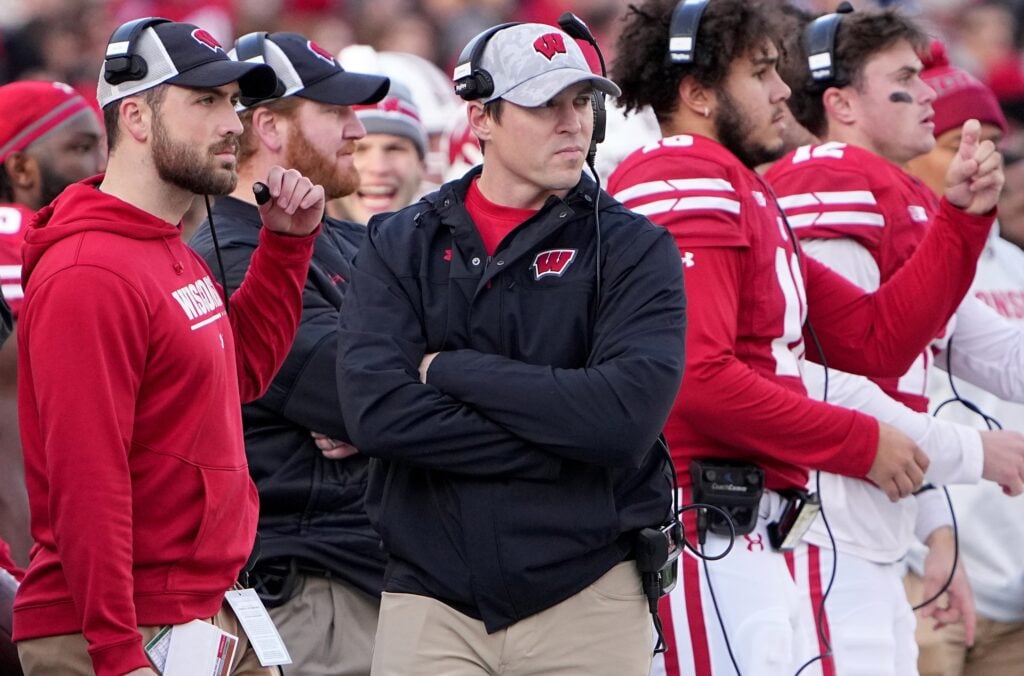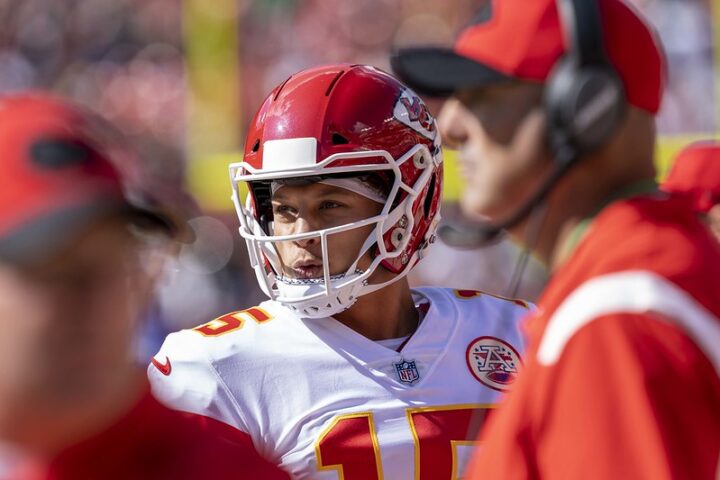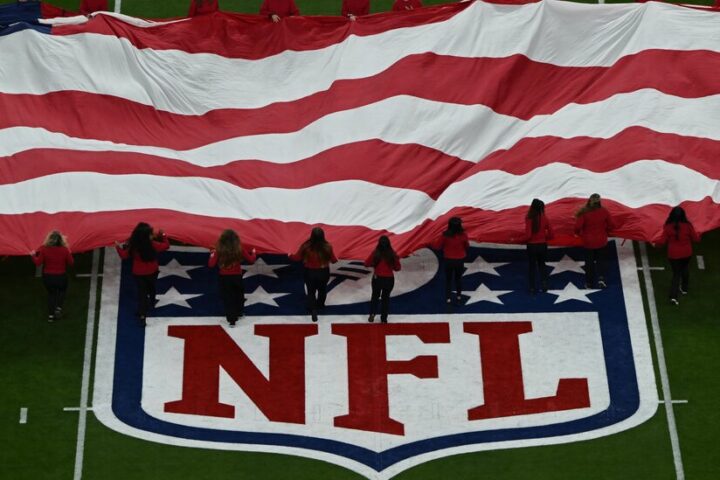Jonathan Gannon became an NFL head coach because, within league circles, he’s one of the most well-respected names in the business. Philadelphia Eagles fans have already begun claiming that while the loss of Shane Steichen is felt, losing Gannon was addition by subtraction. While Philadelphia could have done much worse, hiring Jim Leonhard would be a net positive for the Eagles’ defense heading into 2023 and beyond.
Over the next few days, there will be a million news stories about the interview and about as many “Who is Jim Leonhard?” pieces. While we’ll cover the basics here, there’s no point in spending too much time on it. We’re going to dive deep-ish into what we can expect to see from Leonhard’s defense.
What is the main philosophy? What has made his Wisconsin defenses special? How will the Eagles’ front fit into what Leonhard likes doing, and what kind of coverages does he lean towards?
But let’s get all the boring fluff out of the way first.
UPDATE: Jeremy Fowler reported that the Eagles and Leonhard mutually agreed he would not be taking the team’s vacant defensive coordinator role.
Who Is Jim Leonhard?
Leonhard was a walk-on safety at Wisconsin. And while “grit” is often used to describe midwestern college players, particularly those lacking melanin, it may never have fit a player better. Despite being an All-American in 2002 and 2003, he was not awarded a scholarship until before his senior season, when he was also an All-American.
From there, he went undrafted and was cut during his rookie season. Although he played with Buffalo from 2005-2007, the real story came in 2008. See, he played for the Ravens in 2008, and their defensive coordinator was some guy named Rex Ryan. Ryan left for the Jets in 2009, and he brought Leonhard with him.
Ryan coveted the underdog mentality Leonhard brought to the table. The former NFL head coach is also one of the most well-respected defensive minds of the new millennium, making him a decent mentor for Leonhard to have.
MORE: Eagles’ Former Coordinators in Tough Situations With New Teams
But it’s Dave Aranda’s mentorship after Leonhard retired that really shows in his defense. Coaching Twitter is a whole different beast from normal NFL or College Football Twitter. There are smart analysts out there, but coaches are a different breed. They ingest football for breakfast, lunch, and dinner. And coach Twitter adores Aranda, and that adoration has spread to Leonhard, his pupil.
When Leonhard retired, he spent time learning Aranda’s defensive system. Within three years of retirement, he’d already ascended to the defensive coordinator role with the Badgers, and his defenses were consistently great, even during Wisconsin’s down years.
What makes them special? First, we must define a few things for the audience.
Creepers and Sim Pressures
Talking through creepers and sim pressures could be their own separate pieces of content (foreshadowing?). But we are going to do a few things:
- Define them
- Describe them
- Show how Leonhard uses them
As famous journalist David Skylark once said, “same, but different.” That may be the most succinct way of describing the two without actually defining them. They are both four-man pressures that use second-level defenders as rushers while dropping a first-level defender into coverage.
A sim pressure is about what it sounds like. A defense crowds the line of scrimmage with five or more potential pass rushers, but they only bring four in total. However, a sim pressure is not when two linebackers double-mugging the A gaps drop into coverage because no second-level defender is rushing the passer in that instance.
Additionally, sim pressures are usually associated with man coverage and are used on passing downs.
A creeper is also quite an observational nomenclature. Instead of showing pressure before the snap, the fourth rusher attacks the line of scrimmage from the second level only after the snap or just before, “creeping” toward the line. The rushing second-level defender can come from anywhere and rush to any spot. Tags are associated with the pressures to make it easier for defensive personnel to follow.
Creepers are often paired with zone coverage, and they’re part of the reason why Wisconsin’s run defense has always been so damn good under Leonhard.
Defensive Fronts Leonhard Uses
Some defensive coordinators are more recognizable by their coverage deployment and specific teachings, and others are known for how they change up looks on the front line. Brandon Staley was the poster child of the two-high revolution sweeping the NFL.
Although known as one of this generation’s best all-around defensive minds, Vic Fangio is best known for using Cover 6. DeMeco Ryans thrives off two-high pre-snap looks that turn into middle-of-field-closed coverages post-snap, so he can use an extra defender as part of the run fit from depth.
Buddy Ryan is known for the 46 Bear defense. Wade Phillips is a 3-4 legend. But none of the modern defenses are static on the front lines. Some are quite exotic. The Tennessee Titans have flirted with standing everybody up and moving them around on passing downs. With Leonhard, you’ll see 2-4-5, 3-4, 3-3-5, and 4-2-5 looks.
And with the continued climb in QB runs making their way to the NFL level, college coaches are far more well-equipped to defend those looks. The added benefit of potentially hiring Leonhard is that Sirianni and the offensive staff can pick his brain about where the weak points are defending the option to better deploy it on offense themselves.
The Tite Front was Wisconsin’s base defense, but Leonhard was flexible toward the personnel he had at his disposal and from week to week, depending on opponents. The Tite Front is a three-down front featuring a 4i-0-4i alignment.

The above photo shows what base Tite would look like with four “linebackers” on the field. In the more spread-out world of football at the moment, it looks like a 3-3-5 with an outside linebacker (EDGE) aligned outside of the tight end, should there be one in-line.
This front attacks the B-gap with the two down ends. It’s meant to make offenses run outside of the tackles. The 0-technique is responsible for the backside A gap. The assignments for linebackers aren’t complex, either. You’re responsible for the C gap if there is a run to your side, and you’re responsible for the A gap if it’s a run away from you. The two Apex defenders (EMOL or slot defender) are the force players.
Besides the inside shade of the two ends, what makes the Tite Front different from a traditional 3-4 is the aggressiveness of it. Every player is responsible for a single gap, meaning defenders can play with disruptive intentions.
What could be a more perfect fit for the likes of Jordan Davis and Milton Williams, who are athletic freaks at their respective positions? If Javon Hargraves is retained, it keeps his motor running hot, and with athletic EDGEs like Josh Sweat and Haason Reddick, it gives Leonhard all the options he could ever need.
But as previously stated, Leonhard isn’t resigned to one front. “Peso” is also a well-traveled unit deployed by Leonhard. This is his 2-4-5, which can be used with devastating effects with the right personnel. It’s where Leonhard will consistently shake things up using creepers. It can mimic the more traditional 4-2-5 under or an even look.
How Creepers Help Defending the Run
There is never-ending adaptability with the use of creepers, as long as you have the personnel to use them. Creepers can attack the field or boundary, to or away from the tight end or running back, and they can come off the edge or attack any interior gap. And they do all that while adding layers to the offensive line’s responsibilities, all without sacrificing numbers in coverage. But the biggest help comes against the run.
Creepers do a few things for your run defense. It gets a second-level defender attacking downhill. It also means the defensive line is attacking a different point and usually slanting away from the second-level rusher. And lastly, the dropping defender is first responsible for a run fit, which keeps them at the line of scrimmage instead of immediately bailing into coverage.
It gives a defense the advantage of aggressiveness without sacrificing too much in coverage.
It is much more difficult for offenses to counter creepers than it is for defenses to implement them, and the variety of looks given by Leonhard’s pressures could give offensive linemen nightmares.
We’ll delve into Leonhard’s tendencies in coverage soon enough. The Eagles were a pass-rushing giant in 2022, sacking opposing quarterbacks 70 times, which is the most since the 1989 Vikings.
Creepers and sims are good tools to use on passing downs as well. RPOs are a big part of NFL offenses, and they’re not going away anytime soon. Creepers and sims are meant to confuse protections without sending more than four rushers, which can also affect how a quarterback approaches a particular rep.
Sim pressures can trick a QB into throwing hot, right into the area a defender he thought was rushing backed into. But creepers can have a similar affect without speeding up a QB’s process.
Sean Clifford knows he should have the slant here. He got soft coverage to the boundary, and only four defenders showed a rush pre-snap. His initial read is to the field, where the pressure comes from the second level. He’s done enough to make the MIKE a non-factor in coverage as he initially slides between the hashes following Clifford’s eyes.
But there’s a problem. A usually simple turn and burn has been thwarted by a towering EDGE dropping right back into the slant window. Clifford does everything but release the football, and the rushing linebacker is able to win the arc and finish the sack on third and six.
There are different “paths” for these pressures, and they each have a tag. To the boundary is a BREES path, while the field side is FAVRE. The middle, as you may guess, is MANNING. But those general tags can be changed depending on who runs the system.
To learn more about the Aranda/Leonhard defense, Chris Vasseur “Coach Vass” has compiled just about everything you could ever need to learn about Aranda in his Patreon, and Cody Alexander’s Match Quarters substack is another excellent tool when studying that family of defenses. They are both truly premium content and unbelievably good resources.
What Coverages Does Leonhard Run?
As someone who is far more adept at speaking on coverages than fronts, it should be noted how important the front is to Leonhard’s defenses. And while coverage is king, Leonhard lives by K.I.S.S.
All defenses show a little bit of everything. For instance, we saw far more two-high looks from Leonhard pre-snap against Ohio State than we’re used to seeing. He is, for all intents and purposes, a middle-of-field-closed coach. Like Aranda and Justin Wilcox before him, Cover 3 is king.
However, we shan’t think of modern Cover 3 the same way we used to. Most of what we see these days is a zone-match deployment of the coverage. In the simplest of terms, that means you cover the man within your zone and not simply occupy grass.
Although Cover 3 could be considered his base philosophy, he’s more than willing and able to change things up situationally. Depending on the creeper, it may behoove him to use Cover 2. There are times against true trips that he’ll run many different 4-over-3 split-field coverages.
If the offense asks a question, Leonhard has an answer in coverage. There’s nothing overly complex about how he does things, but the Badgers’ execution under Leonhard was unbelievable over the past few years. Between stunts, creepers, sims, and good execution of simple concepts on the back end, the Eagles defense should improve in 2023, as long as they can bring back some of the talents they collected for 2022.
Fitting Scheme With Talent
We don’t know who Philadlephia will return to their defense next season. According to Sports Info Solutions, the Eagles faced 356 attempts rushing four when filtering out all non-Cover 1-6 coverages (spikes, screens, red zone). Of those 356, 91 attempts (25.6%) came with them playing man coverage.
Leonhard is not a big man-coverage guy, so that shoe fits. If the Eagles keep C.J. Gardner-Johnson around, he’d be an absolute menace as a hybrid defender in Leonhard’s defense. Guys like Reddick and Sweat will be useful as well. Fans may be upset when Reddick drops into coverage 100 times next season, but it will positively impact the defense as a whole.
MORE: The Philadelphia Eagles Could Lose a Lot of Key Players
Davis will thrive as an attacking 0-technique, and Milton Williams was born to slice through the B gap playing as a 4i. Hargrave won’t have any problems producing from his Peso package.
The interesting question comes at linebacker. It wouldn’t surprise me to see Leonhard convince Howie Roseman and Sirianni to bring in a few linebackers that we’d normally see Bill Belichick employ. Whoever he brings in to play the MIKE and WILL have to be at least decent blitzers.
There is a reason NFL teams have had Leonhard on their radar for a few years now. If Philadlephia gives him the opportunity as their defensive architect, they may avoid having the clichéd “Super Bowl hangover.”




